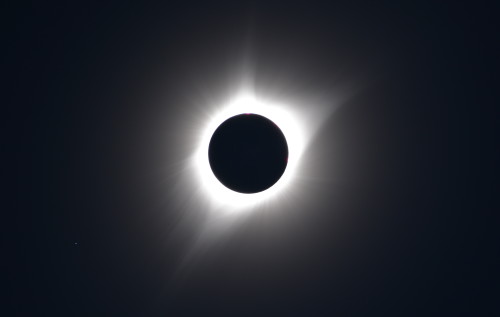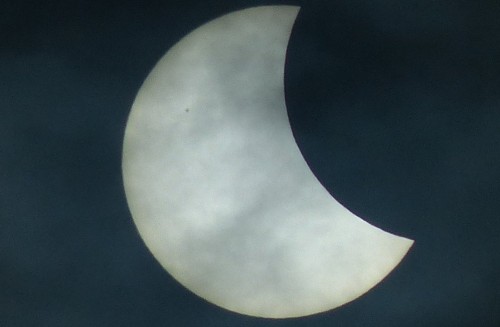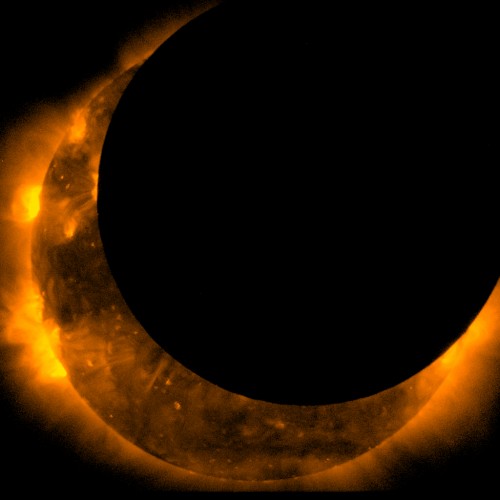Tag archives: eclipse
America’s night in a day

Day’s night: the Great American Eclipse. (Courtesy: Tami Freeman)
By Sarah Tesh
On Monday 21 August, the US witnessed some unusual events. Day turned to night, temperatures dropped as much as 6 °C, animals behaved weirdly and street lights came on in the middle of the day – all because a vast, 115 km-wide shadow swept across the land.
This was, of course, a solar eclipse – where the Moon passed in front of the Sun casting a shadow on Earth. Millions watched with special glasses, home-made pin-hole cameras, digital cameras, and – in the case of scientists – satellites and telescopes.
View all posts by this author | View this author's profile
The American eclipse: wonder, science and festivities
by David Appell in Salem, Oregon, US
The Moon partially blocks the Earth’s view of the Sun at least twice, but the 21 August total solar eclipse – the “Great American Eclipse” – is “likely to be the single most viewed natural phenomenon in history of America”, according to Randall Milstein, an astronomy instructor at Oregon State University. He says a total of 324 million people live within a 9-hour drive of the path of totality.
While the total solar eclipse will span the US – the first to do so since 1891 – the UK will only see a slight partial eclipse, where a sliver of the Moon covers the Sun. Starting over Belfast at 7:37 p.m. BST and leaving Plymouth at 8:33 p.m. BST, this partial eclipse will extend to eastern continental Europe. But it will only be a 4% blockage at best – so be sure to use eclipse safety glasses!
View all posts by this author | View this author's profile
America counts down to the big eclipse

Night in day: the Sun will be temporarily blocked from view. (Courtesy: NASA)
By David Appell in Salem, Oregon, US
On Monday 21 August tens of millions of people will view one of the most remarkable phenomena available on Earth – a total solar eclipse. The shadow created as the Moon blocks out the Sun will sweep across the US in the middle of the day and I’ve been looking forward to it since I learned of it six years ago.
I’m one of the lucky ones – I live in Salem, Oregon, which lies within the eclipse’s 10 km-wide path of totality. Along this path, day will turn dark for about two minutes and the flare of the Sun’s corona will become visible. Birds will roost, crickets will begin to chirp, the temperature will fall about 5 °C, and people will likely gape in awe as humans have no doubt done since our species first began.
View all posts by this author | View this author's profile
Our true place in the universe, an eclipse for insomniacs and how far the Chilean landmass moved last week
By Tushna Commissariat
An image of the solar system – showing our luminous Sun ringed by nine (or is it eight?) evenly spaced planets and the asteroid belt – is a familiar feature in many school textbooks. In fact, such images are so commonplace that we often forget just how wrong they are when it comes to showing the true scale of the solar system. In particular, the billions and billions of kilometres of empty space that lie between each planet are rarely depicted.
Now, filmmakers and friends Wylie Overstreet and Alex Gorosh have “drawn” a realistic model of the solar system on a dry Nevada lakebed, complete with planetary orbits. The duo describes it as “a true illustration of our place in the universe”. Watch the video above to see how the pair planned and executed their massive portrait.
View all posts by this author | View this author's profile
Bristol marvels at awe-inspiring solar eclipse
By Tushna Commissariat and James Dacey
The south-west of England is not exactly known for its sunny skies at this time of year, so many of us in Bristol – home to Physics World HQ – had steeled ourselves to miss out on today’s solar eclipse, which coincidently is on the first day of spring. So, we were rather overjoyed when the Sun shone through the sparse cloud cover for nearly an hour of the celestial treat. While today’s eclipse was technically visible to anyone in North Africa and Europe, totality was only visible to those lucky few who happened to be on the Faroe Islands (where it was actually cloudy for most of the time) and in Svalbard in northern Norway. Here in Bristol, the eclipse peaked at about 9.30 a.m., when 87% of the Sun’s light was blocked by the Moon.
Partial eclipse, meteorites and northern lights enthral a nation

Spot on: this photograph of the Sun taken during today’s eclipse clearly shows a sunspot. (Courtesy: David Bloomfield)
By Hamish Johnston
Earlier today millions of people in north-western Europe had the opportunity to see a partial eclipse of the Sun – or a total eclipse for the lucky few in northern Norway and the Faroe Islands. Although it was a bit hazy here in Bristol, we were treated to spectacular views of the Moon covering 87% of the Sun. We have put up a Flickr album of images taken by colleagues here at IOP Publishing including the amazing photo above. It was taken by David Bloomfield and clearly shows a sunspot in the upper-left portion of the Sun.
View all posts by this author | View this author's profile
Guide to the solar eclipse

Solar eclipse of 2012, which darkened parts of the US and south-east Asia. (Courtesy: JAXA/Hinode)
By James Dacey
On Friday, our old friend the Moon will swing by to remind us that she’s not just there to reflect the Sun’s light; she can sometimes block it out too. A total solar eclipse will be visible to those lucky few people living in the Faroe Islands or the Norwegian archipelago of Svalbard. Many others across Europe, North Africa and Russia will be treated to the (almost as good) spectacle of a partial solar eclipse.
View all posts by this author | View this author's profile